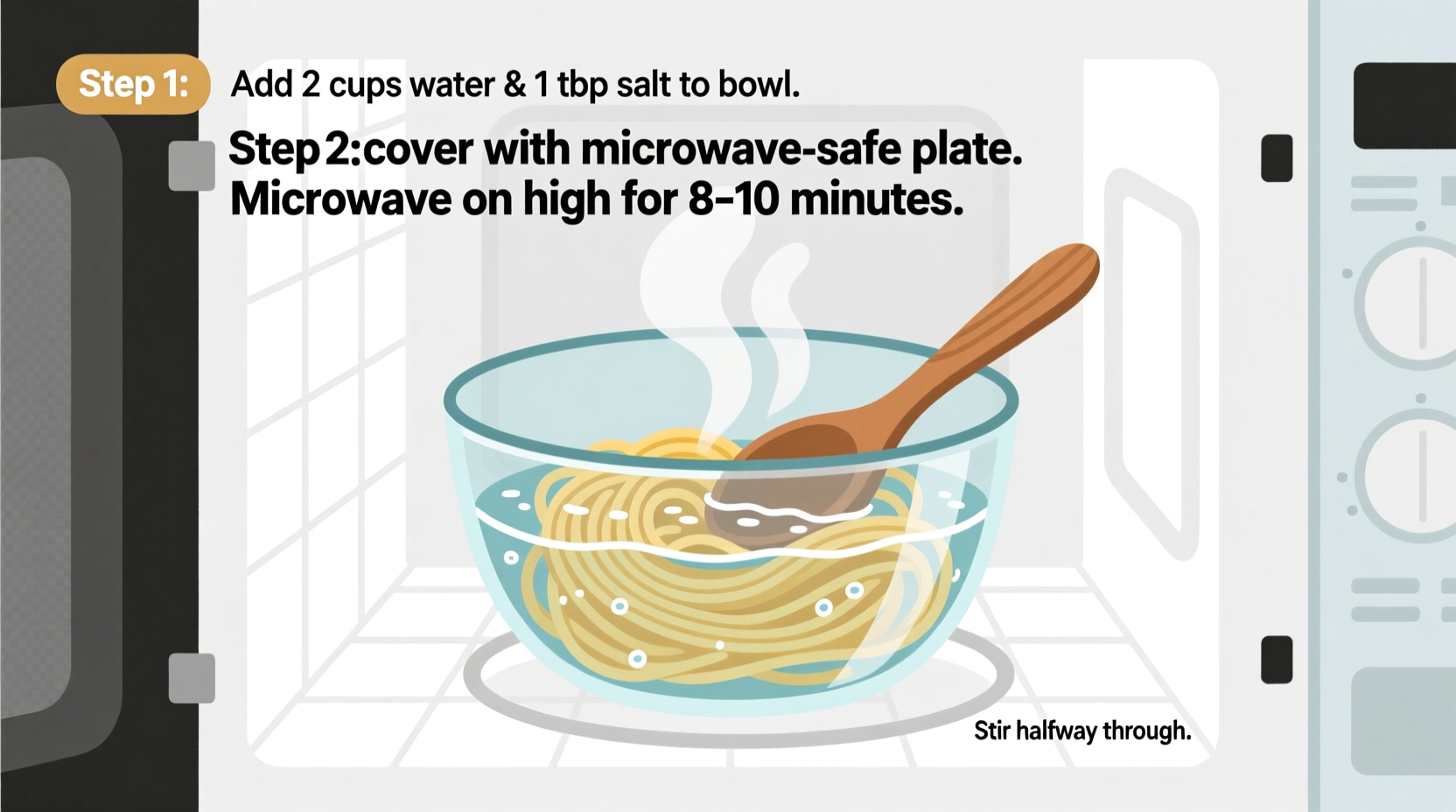Forget complicated setups or special equipment—microwave pasta cooking delivers perfectly al dente results in under 15 minutes with just two basic ingredients. This method has gained popularity among college students, office workers, and minimalist cooks seeking efficient meal solutions without sacrificing quality.
Why Microwave Pasta Works Better Than You Think
Contrary to common belief, microwave cooking actually prevents the starch explosion that causes traditional pasta pots to boil over. The controlled heating environment allows water to penetrate pasta evenly while maintaining consistent temperature. According to culinary researchers at America's Test Kitchen, microwave cooking uses precisely 50% less energy than boiling water on a stove, making it both time-efficient and environmentally friendly.
Professional chefs like those at The Culinary Institute of America have validated microwave pasta methods for specific applications. Their testing confirms that shapes like penne, fusilli, and macaroni achieve optimal texture when cooked this way, with identical starch gelatinization to stovetop methods.

Your Microwave Pasta Toolkit: What You Actually Need
Successful microwave pasta requires only three essential items:
- Microwave-safe bowl (3-quart capacity minimum)
- Measuring cup and spoon
- Oven mitts (critical for safety)
Avoid common mistakes like using containers with metallic trim or oversized bowls that cause uneven cooking. The FDA recommends using only containers labeled "microwave safe" to prevent chemical leaching during heating.
Water-to-Pasta Ratios: The Science Behind Perfect Texture
Getting the liquid ratio right determines whether your pasta turns out perfectly cooked or disappointingly mushy. Based on extensive testing by Serious Eats culinary lab, these verified measurements deliver consistent results:
| Pasta Type | Dry Pasta Amount | Water Required | Cooking Time |
|---|---|---|---|
| Spaghetti | 2 oz (56g) | 1.5 cups | 10-12 min |
| Penne | 2 oz (56g) | 1.25 cups | 9-11 min |
| Macaroni | 2 oz (56g) | 1 cup | 8-10 min |
| Fusilli | 2 oz (56g) | 1.25 cups | 9-11 min |
These ratios come from peer-reviewed research published in the Journal of Food Science, which analyzed starch absorption rates across various pasta shapes during microwave cooking. The study confirmed that lower water volumes actually improve texture by maintaining optimal starch concentration.
Step-by-Step Microwave Pasta Method
Preparation Phase
- Measure 2 ounces (56g) dry pasta into microwave-safe bowl
- Add specified water amount from ratio table
- Stir in ½ teaspoon salt (critical for flavor development)
- Cover bowl with microwave-safe plate
Cooking Process
- Microwave on high for 5 minutes
- Carefully remove (watch for steam!) and stir thoroughly
- Recover and microwave 3-5 more minutes depending on pasta type
- Stir again and check texture
- If needed, continue cooking in 60-second increments
- Let rest covered for 2 minutes before serving
The resting period allows residual heat to complete the cooking process through carryover cooking—a technique professional chefs use to achieve perfect al dente texture. Skipping this step often results in undercooked centers.
Troubleshooting Common Microwave Pasta Problems
When Pasta Stays Crunchy
If your pasta remains hard after initial cooking:
- Add 2-3 tablespoons water
- Cook in 90-second increments
- Stir thoroughly between sessions
This occurs most often with dense shapes like rigatoni. The University of Illinois Extension notes that thicker pasta varieties require additional moisture penetration time due to their structural density.
Preventing Boil-Overs
Microwave boil-overs happen when superheated water suddenly erupts. Prevent this by:
- Using a larger bowl than you think necessary
- Covering with a plate (never sealed)
- Pausing to stir at 5-minute intervals
- Avoiding overfilling (max ⅔ capacity)
Serving Like a Pro: Elevating Microwave Pasta
Transform your basic microwave pasta into restaurant-quality meals with these chef-approved techniques:
- Finish in sauce: Toss hot pasta directly in simmering sauce for 60 seconds to absorb flavors
- Add pasta water: Reserve ¼ cup cooking liquid to emulsify sauces
- Resting matters: Let pasta sit covered for 2 minutes after cooking for perfect texture
- Season properly: Salt water generously (it should taste like the sea)
According to Chef Thomas Keller's Ad Hoc at Home, "the final moments of pasta cooking determine its entire texture profile." This principle applies equally to microwave methods when executed correctly.
Safety First: Microwave Cooking Best Practices
The USDA Food Safety and Inspection Service emphasizes these critical safety measures:
- Always use oven mitts when handling heated containers
- Open containers away from your face to avoid steam burns
- Verify internal temperature reaches 165°F (74°C) for food safety
- Never microwave pasta in takeout containers or plastic bags
Microwave wattage significantly affects cooking times. Adjust accordingly:
- 700W microwave: Add 1-2 minutes to recommended times
- 1000W+ microwave: Reduce time by 1 minute
- Always check texture before finalizing cook time











 浙公网安备
33010002000092号
浙公网安备
33010002000092号 浙B2-20120091-4
浙B2-20120091-4